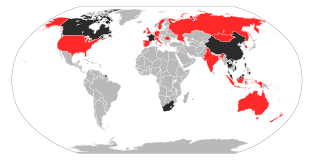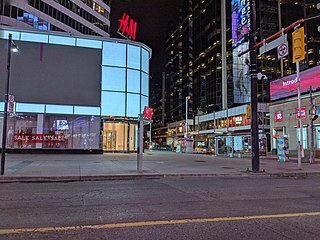
The 2002–2004 outbreak of SARS, caused by severe acute respiratory syndrome coronavirus, infected over 8,000 people from 30 countries and territories, and resulted in at least 774 deaths worldwide.
Sheela Basrur, was a Canadian physician and Ontario Chief Medical Officer of Health and Assistant Deputy Minister of Public Health. She resigned from these positions late in 2006 to undergo treatment for cancer.

In health care facilities, isolation represents one of several measures that can be taken to implement in infection control: the prevention of communicable diseases from being transmitted from a patient to other patients, health care workers, and visitors, or from outsiders to a particular patient. Various forms of isolation exist, in some of which contact procedures are modified, and others in which the patient is kept away from all other people. In a system devised, and periodically revised, by the U.S. Centers for Disease Control and Prevention (CDC), various levels of patient isolation comprise application of one or more formally described "precaution".

In public health, social distancing, also called physical distancing, is a set of non-pharmaceutical interventions or measures intended to prevent the spread of a contagious disease by maintaining a physical distance between people and reducing the number of times people come into close contact with each other. It usually involves keeping a certain distance from others and avoiding gathering together in large groups.

Coronavirus disease 2019 (COVID-19) is a contagious disease caused by the virus SARS-CoV-2. The first known case was identified in Wuhan, China, in December 2019. The disease quickly spread worldwide, resulting in the COVID-19 pandemic.

COVID-19 testing involves analyzing samples to assess the current or past presence of SARS-CoV-2. The two main types of tests detect either the presence of the virus or antibodies produced in response to infection. Molecular tests for viral presence through its molecular components are used to diagnose individual cases and to allow public health authorities to trace and contain outbreaks. Antibody tests instead show whether someone once had the disease. They are less useful for diagnosing current infections because antibodies may not develop for weeks after infection. It is used to assess disease prevalence, which aids the estimation of the infection fatality rate.

The COVID-19 pandemic in Canada is part of the ongoing worldwide pandemic of coronavirus disease 2019. It is caused by severe acute respiratory syndrome coronavirus 2. Most cases over the course of the pandemic have been in Ontario, Quebec, British Columbia and Alberta. Confirmed cases have been reported in all of Canada's provinces and territories.
The COVID-19 pandemic in Norway has resulted in 1,506,934 confirmed cases of COVID-19 and 5,732 deaths.

The COVID-19 pandemic in Ontario was a viral pandemic of coronavirus disease 2019 (COVID-19), a novel infectious disease caused by severe acute respiratory syndrome coronavirus 2 (SARS-CoV-2). The first confirmed case of COVID-19 in Canada was announced on January 25, 2020, involving a traveller who had recently returned to Toronto from travel in China, including Wuhan. Ontario has had the largest number of confirmed COVID-19 cases among Canada's provinces and territories, but due to having the largest population, only ranks sixth adjusted per capita. Ontario surpassed one million lab-confirmed COVID-19 cases on January 24, 2022; one day before the anniversary of the first confirmed case on January 25, 2020.

Bonnie J. Fraser Henry is a Canadian physician and public servant who has been the provincial health officer at the British Columbia Ministry of Health since 2014. Henry is also a clinical associate professor at the University of British Columbia. She is a specialist in public health and preventive medicine, and is a family doctor. In her role as provincial health officer, Henry notably led the response to COVID-19 in British Columbia (BC).
Eileen Patricia de Villa is an American-Canadian physician and public servant who has served as Medical Officer of Health for the City of Toronto since 2017, leading the Toronto Public Health unit.
Allison Joan McGeer is a Canadian infectious disease specialist in the Sinai Health System, and a professor in the Department of Laboratory Medicine and Pathobiology at the University of Toronto. She also appointed at the Dalla Lana School of Public Health and a Senior Clinician Scientist at the Lunenfeld-Tanenbaum Research Institute, and is a partner of the National Collaborating Centre for Infectious Diseases. McGeer has led investigations into the severe acute respiratory syndrome outbreak in Toronto and worked alongside Donald Low. During the COVID-19 pandemic, McGeer has studied how SARS-CoV-2 survives in the air and has served on several provincial committees advising aspects of the Government of Ontario's pandemic response.
The National Public Health Emergency Team for COVID-19 (NPHET) was a National Public Health Emergency Team within Ireland's Department of Health that oversaw and provided national direction, support, guidance and expert advice on developing and implementing a strategy to control the coronavirus disease 2019 (COVID-19) pandemic in Ireland.

BlueDot Inc. is a Canadian artificial intelligence software company based in Toronto, Ontario. The company's flagship product is Insights, a software-as-service used to map the spread of infectious diseases.
The COVID-19 pandemic is an ongoing viral pandemic of coronavirus disease 2019 (COVID-19), a novel infectious disease caused by severe acute respiratory syndrome coronavirus 2 (SARS-CoV-2). The pandemic has affected the Cities of Mississauga and Brampton, and the Town of Caledon, within the Regional Municipality of Peel. As part of the larger closure decisions in Ontario, a stay-at-home order shuttered all nonessential businesses, and caused event cancellations.
The COVID-19 pandemic in Toronto is a viral pandemic of coronavirus disease 2019 (COVID-19), a novel infectious disease caused by severe acute respiratory syndrome coronavirus 2 (SARS-CoV-2), localized in Toronto. Toronto is the most populous city in Canada, and the fourth most populous city in North America.
The following is a timeline of the COVID-19 pandemic in Canada:

Zero-COVID, also known as COVID-Zero and "Find, Test, Trace, Isolate, and Support" (FTTIS), was a public health policy implemented by some countries, especially China, during the COVID-19 pandemic. In contrast to the "living with COVID-19" strategy, the zero-COVID strategy was purportedly one "of control and maximum suppression". Public health measures used to implement the strategy included as contact tracing, mass testing, border quarantine, lockdowns, and mitigation software in order to stop community transmission of COVID-19 as soon as it was detected. The goal of the strategy was to get the area back to zero new infections and resume normal economic and social activities.
This timeline includes entries on the spread of COVID-19 misinformation and conspiracy theories related to the COVID-19 pandemic in Canada. This includes investigations into the origin of COVID-19, and the prevention and treatment of COVID-19 which is caused by the virus SARS-CoV-2. Social media apps and platforms, including Facebook, TikTok, Telegram, and YouTube, have contributed to the spread of misinformation. The Canadian Anti-Hate Network (CAHN) reported that conspiracy theories related to COVID-19 began on "day one". CAHN reported on March 16, 2020, that far-right groups in Canada were taking advantage of the climate of anxiety and fear surrounding COVID, to recycle variations of conspiracies from the 1990s, that people had shared over shortwave radio. COVID-19 disinformation is intentional and seeks to create uncertainty and confusion. But most of the misinformation is shared online unintentionally by enthusiastic participants who are politically active.

During the COVID-19 pandemic in the Netherlands, various measures were taken by the government. On the advice of the Outbreak Management Team (OMT) set up by the National Institute for Public Health and the Environment (RIVM), many successive decisions were taken in a short period of time. The first preventive measures came into effect on Monday, January 27, 2020.









